Building A Winning Bundle🏆 | Every

Listen Up! IH - Episode 31
"The magic of writing is that it can make readers feel less alone in the world. The magic of a writer collective is, perhaps, that it can make writers feel less alone in the world."
👆 That's how Nathan Baschez and Dan Shipper think about their startup - Every.
Every is a media company, writers collective, and also a bundle of business-focused newsletters that readers can subscribe to.
Nathan and Dan eventually want Every to cover every industry, every job role, every company, from waste management to wealth management.
That's why they named their business Every!
But it's not a traditional media company or magazine.
Every is structured as a writer collective, this means:
- Writers have the creative freedom to run a profitable business newsletter as they see fit without anyone influencing their content.
- Readers get a bunch of premium newsletters at a price that's just a bit higher than the cost of subscribing to any single one of them.
- And the company makes enough money to offer editorial help, distribution, and financial support to the writers.
That's a win-win-win business model.
The Every story👇
Every - The Product📰
Every is a bundle of business newsletters, with a focus on analysis and commentary instead of news and scoops.
Writers on Every write long-form pieces on business stories and trends with a practitioner's perspective. As the writers are running businesses of their own, they aren't journalists writing for a newspaper.
The focus is on utility - writing content that is most useful to the reader.
The Every bundle has 13 newsletters with topics ranging from productivity to business strategy to culture.
You can subscribe to them for $200/year or $20/month.
Every has around 2400 paying subscribers and 36000 free subscribers.
A 6% conversion from free to paying subscribers is above the industry standard of 5%.
While the industry average price of paid newsletters is $11, most newsletters in the Every bundle charge $15 a month standalone.
The Business Model💰
As a reader, if I like one or two newsletters in the bundle, then it makes total sense to subscribe to the whole bundle for $20 - even if you arent that interested in the others.
As a writer, Every is somewhere between a personal Substack and a traditional newspaper like the New York Times.
Every helps writers with money, distribution, editorial support, and branding.
Writers get a percentage of the subscription revenue. And if for some reason, they want to leave, they get their email list with them.
When a reader signs up, they are asked their primary newsletter choice. That newsletter writer gets 50% of that reader's revenue.
This is a fair way to split the revenue with writers, and it incentivizes writers to join the bundle without worrying about cannibalizing their own brand.
It's the ideal strategy to get influential writers like Tiago Forte joining the bundle.
This is how Nathan describes it -
"It's win-win for consumers because consumers get access to more stuff, more options for less money. It's a win for creators because consumers are spending a little bit extra than they normally would spend"
But this model didn't spring up suddenly out of the blue. Like most Indie Hacker stories, the Every story has humble beginnings.
It really started with Nathan and Dan's personal Substack newsletters.
Humble Beginnings🔰
Nathan had been successfully writing a business strategy newsletter called Divinations, and Dan had been writing a productivity newsletter called Superorganizers.
Both were paid newsletters hosted on Substack. Both were doing well, they had proven the concept of premium newsletters, and had built an audience for themselves.
But they were side projects, not standalone businesses.
Dan and Nathan wanted to test the next incremental step.
So they ran an experiment, bundled their newsletters into a 3rd newsletter called "The Everything Bundle"
At the time, they hadn't even incorporated a company. They just wanted to see how people would respond to the bundle -
"...first let's make a product that people want and will pay for..."
The Everything Bundle was an instant hit!
The revenue doubled overnight. Readers loved the concept of paying a slightly higher price for a ton of more value.
That's when they knew they had hit upon something valuable, something that could be a proper business.
Eventually, Nathan and Dan incorporated an entity when they touched the $10K MRR mark.
And they left Substack to host the bundle on their own platform.
Leaving Substack📜
Nathan was the first employee at Substack. He was their VP of Product, he understands the platform better than most people.
He thinks Substack is a great option for writers who already have a huge audience and have been writing for a long time. (like journalists quitting newspapers)
But Substack can be hard for someone just starting and still figuring out their newsletter offering.
It offers almost no distribution or editorial support. And when you start a paid newsletter, Substack takes a cut on every subscription, which is a terrible model for any writer trying to scale.
Nathan and Dan realized one thing - great writers have always had mentors and a community to help them hone their craft, refine their writing and make it useful to the readers.
Writers need support.
That's hard to get on Substack.
Plus you get very few customization options when you write on Substack.
If Nathan and Dan wanted full control over the user experience of their newsletter, it had to move on from Substack.
So they built their own content management system, and migrated their content to it.
That's when "the everything bundle" became "Every."
Bundling and Unbundling🔃
This a constant cycle in business.
Small businesses grow horizontally till they are so big that they can be unbundled vertically. Giving birth to more vertical small businesses.
Substack unbundled the newspaper. Individual writers could quit their jobs at prestigious publications like The New York Times, start their own Substacks, and capture a lot more of the value they were creating.
But once a few Substacks grow big enough, it doesn't make sense for them to stay on the platform. They can go on their own, or better still, team up with a bunch of similar writers and offer a bundle.
What Every means to them🤗
When they launched the platform, Dan and Nathan wrote a long essay explaining the concept of Every. They explained their model, their editorial and financial structure, their idea of a writing collective.
And they spoke about what this project means to them, how they think about Every -
"In our best moments, the way we think about what we’re doing is this: The magic of writing is that it can make readers feel less alone in the world. The magic of a writer collective is, perhaps, that it can make writers feel less alone in the world. It has for us. And that is the point."
Related🖇
- Only 2 ways to make money - bundling and unbundling | Listen Up IH episode 11
- Framework: Unbundling | Opportunities
Let's look at the key lessons from Every's story👇
Insights📊
- You don't need a company to build a successful product. Make something useful, incorporate it later.
- The best business models are the ones that make everyone win - the founders, collaborators, and the consumers.
- Business newsletters can make good money, especially because they help the readers make money.
- Starting small, validating one idea at a time is a legit model to build a profitable business.
- A newsletter is a good foundation for a startup. (Ryan Hoover started Product Hunt as a newsletter)
Ideas💡
- Every had to build their own CMS. Build a niche newsletter tool.(like 'Where By Us' did for local newsletters). Focus on helping writers start bundles together, target rising newsletter writers.
- Start a business newsletter focused on a niche topic that you know about, bundle with similar writers.
- Build a newsletter directory. Help new newsletter writers get distribution. Upsell them with editorial services and a community.
- Bundle your product with a related Indie Hacker product. (Andrew Kamphey, Pete Codes, and Chris Osboren did just this.)
Inspiration🤩
- A like-minded co-founder is an unfair advantage. Find them, and then do everything necessary to make it work.
- Nathan and Dan even went for therapy together.
- Keep iterating and improve your offering, this is Nathan's first Product Hunch Launch (6 upvotes), this is second (250 upvotes) and this is the third (388 upvotes).
- Build a positive-sum business, think of how your customers and collaborators can win with you. Make it win-win-win🏆
Growth Channels📈
Every grows mostly from word of mouth, they don't do "content marketing", their content IS marketing.
This is Nathan and Dan's strategy -
- Write really good stuff🤷♂️
- Put it on Twitter and Hacker News.
- Hope it goes viral🤞
2 More strategies for newsletter growth -
- Interview led growth - Interview famous people in your niche, hoping to reach a fraction of their audience with your audience.
- Cross-promotion with other newsletters - Guest post on other newsletters and get them to write in your newsletter. Reach a wider audience this way.
This reflects in Every's traffic as well.
Of 353K visits in the last 6 months, about 60% is direct traffic on the websites - their regular readers.

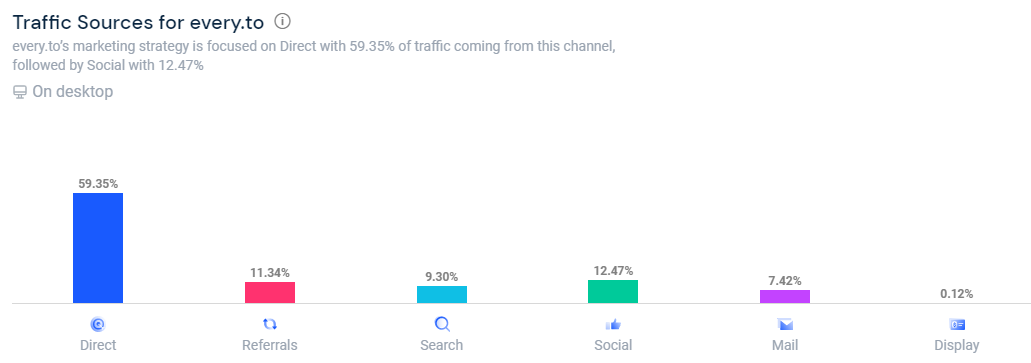
Their top ranking keywords are names of newsletters in their bundle, or titles of their articles -
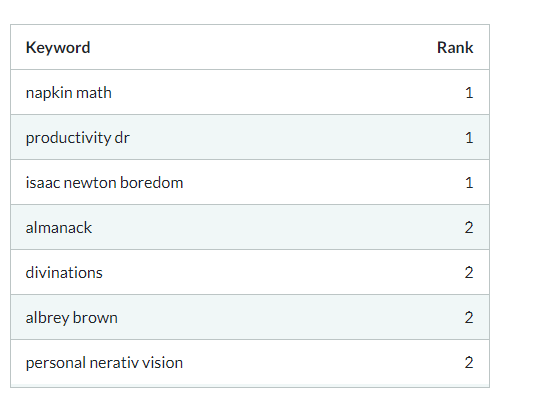
Landing Page Lessons👩🏫
What we can learn from their landing page - every.to
- Very effective landing page. Plenty of white space and a unique but simple font.
- The LP Copy focuses on "40,000+ curious business people" - So there's a a big number and a specific user persona right at the top.
- The first CTA is "Start Trial" - Their annual plan is $200, which is quit expensive, so they offer a 14 day trial plan for $1. The CTA focuses on the simplest action the user can take.
- Then the LP explains what the user gets, plus exact details of the bundle - good way to highlight the influential writers they have on the platform like Tiago Forte, Nat Eliason, Li Jin etc.
- As we scroll down, there are snippets of their best articles, with a question describing the core value prop of each article. As a reader, I feel compelled to click through and read each piece. Questions invoke action!
- Then there's social proof with user testimonials snippets.
- And at the bottom, there's another CTA - "Try it:$1 for 2 weeks"
- The monthly plan is hard to find, you have to go through the FAQ section to find it! - They always emphasize the annual plan. Smart!
Related Trends📈
- The Paid newsletter scene has evolved significantly in past couple of years with the rise of Substack.
- Its interesting to see opposing trends for the keywords "newsletter" and "substack" in Google searches.
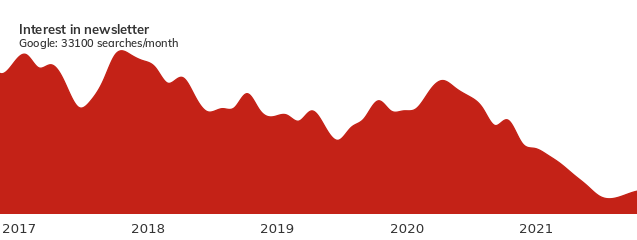
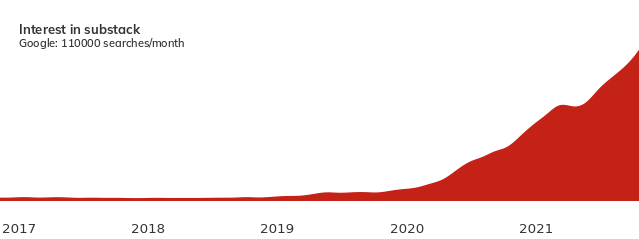
- A lot of research has gone into how much money the top Substacks are making, Backlinko's report is the most comprehensive on this topic - Substack User and Revenue Statistics (2021).
- This graph stands out, Substack's paid subscriber's over time
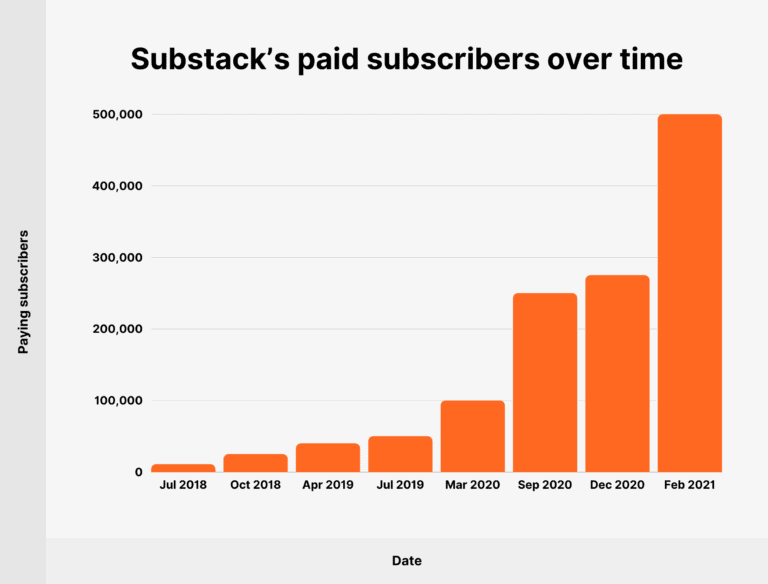
Related Opportunities💰
Indie hacker startups you can acquire from microacquire.com or get inspired by to build your own -
- Value Prop - No Code SaaS that helps user add custom referral and reward system to their newsletter.
- Profit Last month - $1450
- ARR - $20K
- Asking Price - 350K
- Value Prop - Fully-featured website/blog/newsletter builder that supports custom domains, custom templates, and email subscriptions.
- Profit Last month - $130
- ARR - $1K
- Asking Price - $40K
- Value Prop - MicroSaaS that helps you turn your Twitter followers into newsletter subscribers by connecting to your Revue account.
- Profit Last month - $1550
- ARR - $1.6K
- Asking Price - $20K
Links🔗
- How to Make Your Business Model a Win-Win-Win - with Dan Shipper and Nathan Baschez of Every | Indie Hackers Podcast #219
- Find Your Best Ideas With a Newsletter Mastermind | The Nathan Barry Show 027 | YouTube
- Every Founder's Letter
- Substack User and Revenue Statistics (2021) | Backlinko
- Forbes launches massive expansion of paid newsletters | Axios
Thank you for reading🙏
ICYMI : Last week I wrote about the real estate SaaS - The Agent Nest.
You can read the back catalog of all the posts so far on the Listen Up IH website
Every week, I share the most actionable insights and inspiring tips from successful Indie Hackers FOR aspiring Indie Hackers
Ideas + Insights + Inspiration for building profitable internet businesses💪
Sign up to Listen Up! IH and join 1500+ spirited Indie Hackers who read this newsletter every week.
Thanks to Seth King for editing this post
Google trends chart courtesy UnderTheRadar.io.
Cheers,
